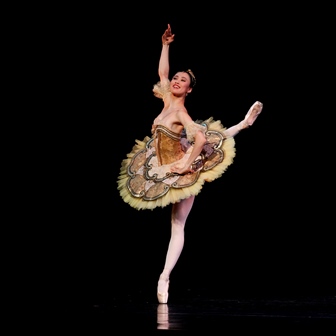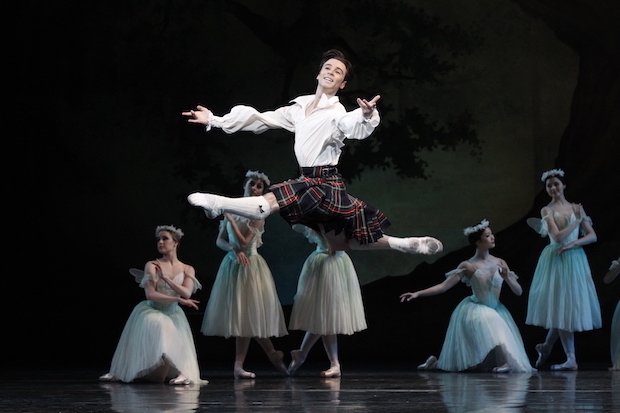I saw this program twice in 2013 and have to admit that, apart from outstanding performances by one or two dancers in each of the casts I saw, I was somewhat underwhelmed. But this screening by the Australian Ballet as part of its 2020 digital season left me absolutely thrilled.
The Paquita we see is really an excerpt from a full-length ballet of the same name that is rarely seen these days. Its choreography is by Marius Petipa and what we see in this excerpt is Petipa’s classicism. We see it in spades, especially in the way the dancers hold their bodies, erect and proud, with a straight spine as the central axis, and in the kinds of steps the dancers perform. In his introductory remarks to the streamed production, David McAllister calls it a ‘ballet ballet’. And so it is.
The cast is led by Lana Jones and Kevin Jackson. They show off their classical technique brilliantly. Jones. for example, has a series of fouetté turns in one solo and she launched straight into eight (or it could even have been nine) double turns in succession. Spectacular. The four soloists, Amy Harris, Juliet Burnett, Ako Kondo and Miwako Kubota, all danced with extraordinary skill. Standing out for me were Amy Harris with her perfectly controlled fouetté relevés, and Ako Kondo who made a thrilling entrance with a series of grands jetés and then proceeded to dazzle us with some exceptional turning steps, including some pretty much perfect double turns in attitude. Then I can’t forget the corps de ballet (which in fact included some of today’s principal artists such as Benedicte Bemet and Dimity Azoury). The corps danced with great style and each one of them looked as though she loved performing.

Then came La Sylphide with Leanne Stojmenov as the Sylph and Daniel Gaudiello as James, with choreography by Erik Bruhn after August Bournonville. Act I raced along and I enjoyed Gaudiello’s acting from the opening moments when, asleep in his armchair, a little dream-like smile kept hovering across his face as the Sylph danced around him. Stojmenov was a truly beautiful Sylph with an understanding of the needs of the Romantic style of movement. She seemed so light, so supernatural, so at home with the gentle tilt of the head and the forward-leaning style of movement we expect in the Romantic style. She has a beautifully coordinated body and it is quite fascinating to watch the relationship between legs, arms, upper body and head, each seeming to be separate actions yet at the same time part of an alluring whole.
Of course both Gaudiello and Stojmenov came into their own in Act II. Gaudiello’s beats were breathtaking as was his ability to perform with the ballon and apparent ease that characterises the Bournonville style. And Stojmenov continued with her Romantic and supernatural manner. Apart from the technical aspects of their performance, Stojmenov and Gaudiello also interacted so well that the story simply sped along, taking us with it. It was a perfect pairing for this ballet. The issues I felt when I saw the program live were mostly still there, but seemed no longer to matter, thanks to Stojmenov and Gaudiello. Bouquets to them both.
Colin Peasley as Madge and Andrew Wright as Gurn also gave strong performances and I enjoyed as well being backstage at the Sydney Opera House while the overture to La Sylphide was playing. I can’t wait to look again.
My reviews of previous performances are at these links: Melbourne; Sydney. I was also lucky enough to see the full-length Paquita as restaged by Pierre Lacotte for the Paris Opera Ballet but it was before I started this website and, unfortunately, I have no written record of the performance.
Michelle Potter 30 May 2020
Featured image: Daniel Gaudiello as James in La Sylphide, Act II. The Australian Ballet, 2013. Photo: © Jeff Busby


This bill of Paquita and La Sylphide was extremely important to me! 2013 I think, I was engaged by Aussie ballet and dear Fiona Tonkin and myself worked hard with the principals and made I think, a great performance with all at Aussie ballet! David was such a cool person and personality and just wish you well my friend and future for Aussie ballet!
Hi Martin, I didn’t know you were with TAB in 2013. I guess I didn’t know you then since we didn’t meet until I was in Wellington in 2018 to do the Russell Kerr lecture. Anyway, I thought Leanne and Daniel were just brilliant as The Sylph and James respectively, so whatever work you and Fiona put into that partnership really worked.
How lovely to be reminded of the vivacious style and contained yet vigorous technique in Bournonville ballets.
During Lockdown I have been reshelving library books and was thrilled to read again what Richard Buckle – in The Adventures of a Ballet Critic – wrote about La Sylphide which he saw on that celebrated invitation visit of English dance critics to Royal Danish Ballet in 1951. Poul Gnatt ( later the founder of New Zealand Ballet in 1953) was the RDB’s favourite James at the time. Buckle wrote: “This touching ballet, our introduction to the Danish company, was beautifully done, and two shining merits of the Royal dancers at once became evident: selfless devotion to detail inculcated in every one of them, and their exceptional ability for mime. I had seldom seen so thorough a performance. Margrethe Schanne was a charming Sylphide, but the rarities of this production were Poul Gnatt’s rendering of the tormented James, and that of Gerda Karstens as the Witch. The economy, placing and timing of Gnatt’s gestures, his utter conviction and the virile sweetness of his expression in lyrical passages I knew we British had nothing to equal.” Poul told me many stories about his time at RDB. I should write about them sometime. Meantime we still cherish the Bournonville pedigree that Gnatt brought to New Zealand — which is where of course in time the seeds were sewn in Martin James’ fine dance sensibilities that in later years saw him rise to great heights in his own career at Royal Danish Ballet. It’s been some years since Royal New Zealand Ballet staged Bournonville repertoire, but New Zealand School of Dance has recently enjoyed a residency of Henning Albrechtsen, outstanding teacher of the Danish heritage whose every class is a work of art. Good things last.
Thanks for reminding us of Richard Buckle’s comments. It sent me back to an issue of Dance Perspectives from 1974 — Erik Aschengreen’s ‘The Beautiful Danger: Facets of the Romantic Ballet.’ Looking back through my various writings on and reviews of La Sylphide, I find that I have used the expression ‘beautiful danger’ frequently as it seems to encapsulate so much about La Sylphide. As for Poul Gnatt, yes you should write about the stories he told you!
Coincidentally, I have been making a timed summary of an oral history interview I did with Alan Alder way back in 1999. In it he talks about dancing Konservatoriet in London in 1965 when it was performed by the Australian Ballet at the Commonwealth Arts Festival. Alan had only recently come back to Australia from several years dancing with various companies in London, including the Royal Ballet and was very nervous at having to perform ‘all those pliés’ on the Covent Garden stage in front of his London-based colleagues. Poul of course staged the ballet (as Le Conservatoire) for the Australian Ballet, and as you mention in your article on Poul in The Royal New Zealand Ballet at 60, the production and performance was well received. Alan needn’t have worried!.
Hello Michelle
Today was red-letter since the box of review copies of Kristian Fredrikson, Designer arrived at my letter box. After an appropriate libation to celebrate this fine achievement I switched on the Arts tv channel, to help calm me down before bed — but found The Australian Ballet’s 2013 production of La Sylphide about to screen. I heartily agree with all the words you used, following TAB’s 2020 streaming of the film, to describe the splendid performances of Leanne Stojmenov and David Gaudiello in the lead roles. Fiona Tonkin and Martin James helped to stage and style this production, demonstrating yet another New Zealand link to the Bournonville heritage brought here by Poul Gnatt. The TAB production was that of “Erik Bruhn, after Bournonville”. Bruhn was godfather to Gnatt’s first born son — and there are good stories to be told about that friendship as well. Ties that bind.